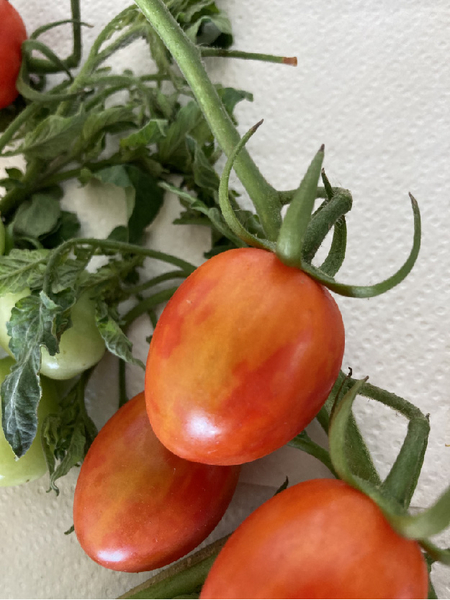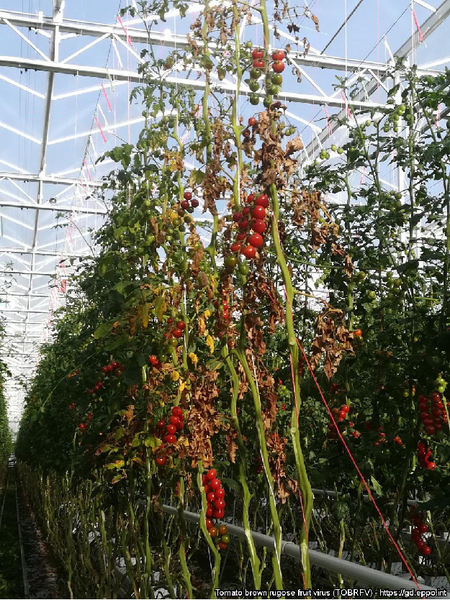Tomato brown rugose fruit virus
ToBRFV, Tobamovirus fructirugosum
Profile
ToBRFV belongs to the tobamoviruses, which are very persistent, highly infectious, plant-pathogenic viruses that are transmitted mechanically and via the seed.
ToBRFV first appeared in Israel and Jordan in 2014/2015 ("Jordan virus"). The virus was confirmed in Austria for the first time in 2021.
Biology
Tobamoviruses are rod-shaped, extremely persistent, long-lived and highly infectious plant pathogenic viruses. In addition to ToBRFV, they also include the tomato mosaic virus (ToMV), the tobacco mosaic virus (TMV) and the cucumber green mosaic virus (CGMMV). Tobamoviruses can survive and remain infectious on seed trays, cultivation tools, greenhouse surfaces, hands, clothing and soil particles for long periods of time. They are very easily transmitted mechanically, but are also transmitted via the seed. Although there are no animal vectors for tobamoviruses, ToBRFV is transmitted mechanically by bumblebees. If young tomato plants are infected with ToBRFV, the virus is systematically distributed throughout the plant and can be detected in all parts of the plant. If, on the other hand, older tomato plants are infected, ToBRFV is not found in all parts of the plant.
Damage symptoms
Affected tomato fruits can show yellow spots or a lack of colouring, but also brown and wrinkled spots ("rugose fruit"). Typical symptoms are mosaic-like discolouration, but also bulging and deformation of the leaves. In some cases, necrosis of the sepals can be observed. In varieties that show little tolerance to the virus, the plants may die completely. The following symptoms were observed during the outbreaks in Austria: non-ripening fruit, small, deformed, sometimes chlorotic leaves at the shoot tips and chlorotic leaf spotting.



Distribution
ToBRFV first appeared in Israel in 2014 and was described as "Tomato brown rugose fruit virus", a new tobamovirus, in 2016. In Austria, the virus was detected for the first time in 2021, with outbreaks confirmed in three federal states. Outbreaks of ToBRFV have now been documented in numerous countries worldwide.
Spread and transmission
The primary route of spread is via infected seeds and young plants. As tobamoviruses are very easily transmitted mechanically, further spread in production facilities occurs via the working staff (hair, clothing, hands, mobile phones, shoes, etc.), via tools (all cultivation tools, watering tools, etc.) and via greenhouse inventory (harvest trolleys and crates, all shelves and greenhouse surfaces, etc.). Other routes of infection include infected plant residues from previous crops, resprouting seeds, infected soil, irrigation water or nutrient solutions and mechanical transmission via bumblebees. ToBRFV is very persistent. Studies have shown that it can survive on hands and gloves for at least two hours and on some greenhouse surfaces for up to six months. As the virus is widespread and is common in some tomato-producing countries, it is important to consider infection of crops through infected, processed or consumed fruiting vegetables.
Economic significance
The reduction in yield caused by the virus is difficult to estimate, as the severity of symptoms varies greatly depending on the variety. In the case of non-resistant/tolerant varieties, the plants may die completely. In tomatoes, resistance to tobamoviruses initially proved to be ineffective against ToBRFV. However, ToBRFV resistance is now available for tomatoes, and since 2022 many seed producers have been offering new tomato varieties that are resistant/tolerant to ToBRFV. In peppers, the well-known tobamovirus resistance genes are also effective against ToBRFV. Experience to date has shown that, despite the effort involved in adapting to new varieties, it is definitely advisable for vegetable producers to switch to resistant/tolerant tomato varieties.
Prevention and control
If plants are infected with tobamoviruses, as with all plant pathogenic viruses, no curative (=healing) measures are possible. This means that the prevention of infections and their spread is of utmost importance.
The use of healthy, infection-free seed and young plant material, as well as strict adherence to and monitoring of all essential hygiene measures in production facilities, and regular checks of crops for symptoms, are therefore essential preventative measures.
Phytosanitary status
It is no longer possible to eradicate or contain the ToBRFV. For this reason, the classification as a quarantine pest was lifted on 1 January 2025 (new Implementing Regulation (EU) 2024/2970). This means that certain measures (reporting obligation, monitoring of spread, legal requirements for eradicating outbreaks, hygiene and disposal of infected material) no longer apply. However, compliance with strict hygiene is still essential in the fight against ToBRFV, but is now the responsibility of the farms. Nevertheless, measures to ensure high-quality seed and planting material remain in place.
Specialist information
We are a National Reference Laboratory (NRL) for the detection of phytopathogenic quarantine pathogens, including the detection of plant pathogenic viruses. This also obliges us to use internationally specified methods of analysis and to participate in international ring tests.
Official plant protection service: Information on the risk of introduction and measures
Services
We detect tobamoviruses and also ToBRFV in plants and in seeds by molecular biology. As a standard procedure for ToBRFV, a real-time PCR method (RT-qPCR) is used. If needed, conventional RT-PCR and sequence analysis can be used to confirm the virus. Analysis usually takes two to three business days (approximately four business days for sequence analysis).
Last updated: 14.01.2025
automatically translated